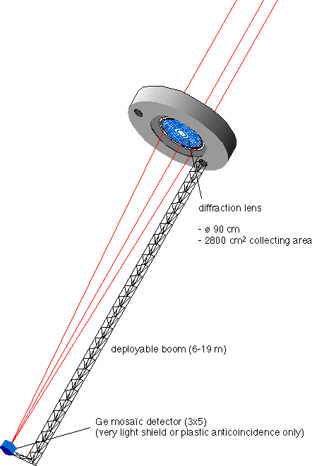MAX
: A Tunable Crystal Diffraction Telescope for Spaceborne Operation
 Ultimately,
the concept of a crystal diffraction telescope should be put to use in
space where longer exposures and steady pointing will result in outstanding
sensitivities. MAX (artists view), a space
borne crystal diffraction telescope using a gamma-ray lens will consist
of a tunable crystal diffraction lens (see : the
prototype tunable lens) situated on a stabilized spacecraft, focusing
gamma-rays onto a small array of germanium detectors perched on an extendible
boom (6-19 m).
Ultimately,
the concept of a crystal diffraction telescope should be put to use in
space where longer exposures and steady pointing will result in outstanding
sensitivities. MAX (artists view), a space
borne crystal diffraction telescope using a gamma-ray lens will consist
of a tunable crystal diffraction lens (see : the
prototype tunable lens) situated on a stabilized spacecraft, focusing
gamma-rays onto a small array of germanium detectors perched on an extendible
boom (6-19 m).
In order to take maximum advantage of the particular properties of
a focused gamma ray beam, a germanium detector matrix
will be used similar to the one used for our balloon telescope CLAIRE
consists of 3x5 detector elements, each one with a geometric surface of
3x3 cm and a height of 7-8 cm. The 2.8 cm FWHM focal spot produced by the
lens will optimally be pointed at one of the central detector elements.
Using isotopically enriched 70Ge as detector material will reduce the b-
background component in the energy range of the lens while the enhanced
b+
production only effects the background above 1.5 MeV. Further reduction
of the non-localized nb
components will be possible using the 15 matrix segments. The matrix also
offers the possibility to monitor the remaining background simultaneously
to the astrophysical observation. Since the spacecraft is seen under a
small solid angle, a low intensity of cosmic-ray induced background is
anticipated, this will allow us to use a detector shielded only by a very
light anticoincidence shield.
Since the focal length of the lens is increasing with energy, a retractable
boom (i.e.. a coilable tube mast) will be used to vary the distance between
spacecraft and detector along the optical axis of the lens. Booms have
been used in gamma-ray astronomy on Apollo 15 with a NaI detector and on
Mars-Observer for the Ge detectors. In both cases, the extension was around
7 m.
Deploying the detector on a boom instead of the diffraction lens has
several striking advantages: The mechanical requirements on the mast rigidity
are less severe since a Germanium detector array is small and lightweight
and thus easy to handle on a boom; moreover, twists and bends of even up
to a few cm’s are tolerable, as the focal spot (ø 2.8 cm) can wander
around on the detector array (total surface 9x15cm) without significant
loss of sensitivity. On the other hand, the stringent requirements for
the pointing of the lens (typically ~ 5”) can be satisfied on board the
pointed and stabilized spacecraft. Finally, moving the detector away from
the spacecraft reduces the background by up to an order of magnitude. In
order to have a mechanically redundant system, the spacecraft will feature
two ‘detector-boom systems’. If both detectors were to be operated at the
same time, different energy-bands could be observed simultaneously, or,
maximum sensitivity at one energy band can be achieved by combining the
two collector-zones.
The sensitivity calculations shown below assume a lens configuration
with 544 Ge crystals, mostly with a 2 * 2 cm^2 surface, and a total
lens area of 2676 cm^2. The mosaic width is assumed to be 10 arc seconds,
and the crystals are 1.5 cm thick. The focal length would be 16.6 m at
511 keV, increasing linearly with energy. The calculations assume a detector
made up of 70Ge-enriched HPGe elements with a 3*2 cm^2 surface and length
of 7 cm. The detector efficiency was assumed to be 80 % at 200 keV, 54
% at 511 keV, and 39 at 1000 keV. The background was estimated using
a fit to the GRIS continuum background spectrum for a 70Ge-enriched HPGe
detector during a balloon flight in Alice Springs in 1992. The background
was reduced by a factor of five to roughly account for the lower mass of
the anticoincidence shield needed, which reduces the contribution of secondary
particles. This gives a background estimate of $9.42 \cdot 10^{-4} \left(
\frac{E}{100keV} \right)^{-1.054}$ counts cm$^{-3}$ s$^{-1}$ keV$^{-1}$.
This is of course a very crude estimate and emphasizes the need for detailed
Monte Carlo background simulations.
 Ultimately,
the concept of a crystal diffraction telescope should be put to use in
space where longer exposures and steady pointing will result in outstanding
sensitivities. MAX (artists view), a space
borne crystal diffraction telescope using a gamma-ray lens will consist
of a tunable crystal diffraction lens (see : the
prototype tunable lens) situated on a stabilized spacecraft, focusing
gamma-rays onto a small array of germanium detectors perched on an extendible
boom (6-19 m).
Ultimately,
the concept of a crystal diffraction telescope should be put to use in
space where longer exposures and steady pointing will result in outstanding
sensitivities. MAX (artists view), a space
borne crystal diffraction telescope using a gamma-ray lens will consist
of a tunable crystal diffraction lens (see : the
prototype tunable lens) situated on a stabilized spacecraft, focusing
gamma-rays onto a small array of germanium detectors perched on an extendible
boom (6-19 m).